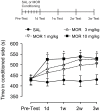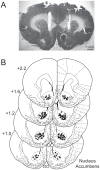Blocking TRPV1 in nucleus accumbens inhibits persistent morphine conditioned place preference expression in rats
- PMID: 25118895
- PMCID: PMC4131889
- DOI: 10.1371/journal.pone.0104546
Blocking TRPV1 in nucleus accumbens inhibits persistent morphine conditioned place preference expression in rats
Retraction in
-
Retraction: Blocking TRPV1 in Nucleus Accumbens Inhibits Persistent Morphine Conditioned Place Preference Expression in Rats.PLoS One. 2020 Mar 6;15(3):e0230396. doi: 10.1371/journal.pone.0230396. eCollection 2020. PLoS One. 2020. PMID: 32142535 Free PMC article. No abstract available.
Abstract
The function of TRPV1 (transient receptor potential vanilloid subfamily, member 1) in the central nervous system is gradually elucidated. It has been recently proved to be expressed in nucleus accumbens (NAc), a region playing an essential role in mediating opioid craving and taking behaviors. Based on the general role of TRPV1 antagonist in blocking neural over-excitability by both pre- and post-synaptic mechanisms, TRPV1 antagonist capsazepine (CPZ) was tested for its ability to prohibit persistent opioid craving in rats. In the present study, we assessed the expression of TRPV1 in nucleus accumbens and investigated the effect of CPZ in bilateral nucleus accumbens on persistent morphine conditioned place preference (mCPP) in rats. We also evaluated the side-effect of CPZ on activity by comparing cross-beam times between groups. We found that morphine conditioned place preference increased the TRPV1 expression and CPZ attenuated morphine conditioned place preference in a dose-dependent and target-specific manner after both short- and long-term spontaneous withdrawal, reflected by the reduction of the increased time in morphine-paired side. CPZ (10 nM) could induce prolonged and stable inhibition of morphine conditioned place preference expression. More importantly, CPZ did not cause dysfunction of activity in the subjects tested, which indicates the inhibitory effect was not obtained at the sacrifice of regular movement. Collectively, these results indicated that injection of TRPV1 antagonist in nucleus accumbens is capable of attenuating persistent morphine conditioned place preference without affecting normal activity. Thus, TRPV1 antagonist is one of the promising therapeutic drugs for the treatment of opioid addiction.
Conflict of interest statement
Figures







Similar articles
-
TRPV1 modulates morphine-induced conditioned place preference via p38 MAPK in the nucleus accumbens.Behav Brain Res. 2017 Sep 15;334:26-33. doi: 10.1016/j.bbr.2017.07.017. Epub 2017 Jul 19. Behav Brain Res. 2017. PMID: 28734766
-
Enhanced ability of TRPV1 channels in regulating glutamatergic transmission after repeated morphine exposure in the nucleus accumbens of rat.Brain Res. 2017 Apr 1;1660:47-57. doi: 10.1016/j.brainres.2017.02.002. Epub 2017 Feb 7. Brain Res. 2017. PMID: 28188777
-
Transient receptor potential vanilloid 1 mediates cocaine reinstatement via the D1 dopamine receptor in the nucleus accumbens.J Psychopharmacol. 2019 Dec;33(12):1491-1500. doi: 10.1177/0269881119864943. Epub 2019 Aug 21. J Psychopharmacol. 2019. PMID: 31432769
-
Blockade of TRPV1 Inhibits Methamphetamine-induced Rewarding Effects.Sci Rep. 2018 Jan 17;8(1):882. doi: 10.1038/s41598-018-19207-2. Sci Rep. 2018. PMID: 29343767 Free PMC article.
-
Impairment of opiate-mediated behaviors by the selective TRPV1 antagonist SB366791.Addict Biol. 2017 Nov;22(6):1817-1828. doi: 10.1111/adb.12460. Epub 2016 Oct 11. Addict Biol. 2017. PMID: 27730727
Cited by
-
Molecular Targets of Cannabidiol in Neurological Disorders.Neurotherapeutics. 2015 Oct;12(4):699-730. doi: 10.1007/s13311-015-0377-3. Neurotherapeutics. 2015. PMID: 26264914 Free PMC article. Review.
-
Retraction: Blocking TRPV1 in Nucleus Accumbens Inhibits Persistent Morphine Conditioned Place Preference Expression in Rats.PLoS One. 2020 Mar 6;15(3):e0230396. doi: 10.1371/journal.pone.0230396. eCollection 2020. PLoS One. 2020. PMID: 32142535 Free PMC article. No abstract available.
-
Multifunctional TRPV1 Ion Channels in Physiology and Pathology with Focus on the Brain, Vasculature, and Some Visceral Systems.Biomed Res Int. 2019 May 27;2019:5806321. doi: 10.1155/2019/5806321. eCollection 2019. Biomed Res Int. 2019. PMID: 31263706 Free PMC article. Review.
-
Blockade of transient receptor potential cation channel subfamily V member 1 promotes regeneration after sciatic nerve injury.Neural Regen Res. 2015 Aug;10(8):1324-31. doi: 10.4103/1673-5374.162770. Neural Regen Res. 2015. PMID: 26487864 Free PMC article.
-
The role of locus coeruleus nucleus TRPV1 receptors in the development and expression of morphine dependence.Iran J Basic Med Sci. 2019 Oct;22(10):1186-1191. doi: 10.22038/ijbms.2019.35055.8338. Iran J Basic Med Sci. 2019. PMID: 31998461 Free PMC article.
References
-
- O'Brien CP (1997) A range of research-based pharmacotherapies for addiction. Science 278: 66–70. - PubMed
-
- Matta JA, Ahern GP (2011) TRPV1 and synaptic transmission. Curr Pharm Biotechnol 12: 95–101. - PubMed
-
- Micale V, Cristino L, Tamburella A, Petrosino S, Leggio GM, et al. (2009) Altered responses of dopamine D3 receptor null mice to excitotoxic or anxiogenic stimuli: Possible involvement of the endocannabinoid and endovanilloid systems. Neurobiol Dis 36: 70–80. - PubMed
Publication types
MeSH terms
Substances
LinkOut - more resources
Full Text Sources
Other Literature Sources

